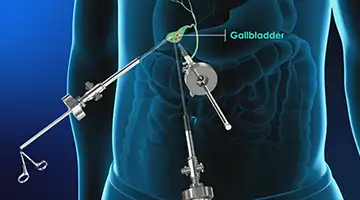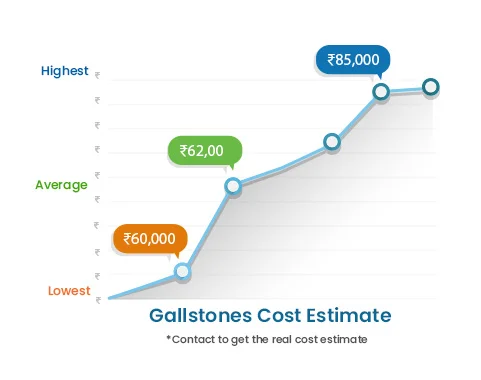BEST GALLSTONE SURGERY IN Delhi NCR
Gallstone surgery in Delhi NCR is now highly affordable with Glamyo Health. Our laparoscopic surgeons carry out the gallbladder removal surgery - cholecystectomy through highly-advanced procedure involving minimal pain and scarring with shorter recovery period. All the hospitalization hassles are taken care of by Glamyo Health care buddy.
Glamyo Health offers free doctor consultation for advanced laparoscopic gallstone surgery in Delhi NCR. Get in touch with us for the best and most affordable laparoscopic gallstone surgery in Delhi NCR.

1 Lakh+
Happy Patients
350+
Doctors
200+
Hospitals
40+
Cities
40,000+
Surgeries
WHY BOOK GALLSTONE SURGERY WITH GLAMYO HEALTH?
 Best Surgeons
Best Surgeons
 1 Day Discharge
1 Day Discharge
 Free Follow Ups
Free Follow Ups
 Free Pick Up & Drop Service
Free Pick Up & Drop Service
 All Insurances Covered
All Insurances Covered
 Advanced Procedure
Advanced Procedure
BEST GALLSTONE SURGERY IN Delhi NCR
Gallstones are crystallized digestive fluid deposits that grow inside the gallbladder. The gallbladder is a tiny pear-shaped organ positioned beneath the liver on the right side of the belly. The gallbladder stores and releases bile, a digestive fluid produced by the liver. Gallstones can be as small as a grain of rice or as large as a golf ball. They obstruct the bile duct, resulting in gallbladder inflammation or infection, known medically as Cholecystitis, which can lead to life-threatening complications if left untreated.
Gallstones require immediate treatment & surgeries as they are extremely painful, You can get in touch with Glamyo Health and get the best gallstone treatment in Delhi NCR, by the best gallbladder removal specialists in Delhi NCR in the best gallbladder removal clinic nearby.

GALLSTONE DOCTORS IN Delhi NCR
View AllGALLSTONE HOSPITALS & CLINICS IN Delhi NCR
View AllGALLSTONE SURGERY COST IN Delhi NCR
View All
Type of surgery : Gallstone
Hospitalization time : 1-2 days
Cost range : 60,000 INR to 85,000 INR, Avg. 62,000 INR
For the Cost Estimate : CALL NOW
For the Cost Estimate : CALL NOW
GALLSTONE TREATMENT REVIEWS IN Delhi NCR
View All
FEROZ Ahmad
Gallstone
Good morning, my name is Feroz Ahmed. For the past few days or weeks I had been troubled with the Gallstone problem and especial read more

 Gallstone | Surgeries
Gallstone | Surgeries Dr. Raj Kumar Singh4
Dr. Raj Kumar Singh4  Apollo Spectra Hospi...4.6 (100)
Apollo Spectra Hospi...4.6 (100) New Delhi
New Delhi

mamta mishr ...
Gallstone
Hi, I am Mamta Mishra. All the arrangements, hospital staff, paperwork and services were carefully coordinated by the Glamyo Hea read more

 Gallstone | Surgeries
Gallstone | Surgeries Dr. Shuddhatam jain4
Dr. Shuddhatam jain4  Metro Noida
Metro Noida  New Delhi
New Delhi

Sunita
Gallstone
Hello, my name is Deepak and I got done with my wife (Sunita)'s surgery through Glamyo Health. They advised me to Delhi Surgical read more

 Gallstone | Surgeries
Gallstone | Surgeries Dr. Raj Kumar Singh4
Dr. Raj Kumar Singh4  Delhi Surgical Cente...4.3 (150)
Delhi Surgical Cente...4.3 (150) New Delhi
New Delhi

Jasvinder S ...
Gallstone
Hello friends, my name is Jaavinder, we are very happy to choose Glamyo Health for surgery and everything was well Organised by read more

 Gallstone | Surgeries
Gallstone | Surgeries Dr. Kapil Aggarwal4
Dr. Kapil Aggarwal4  Sukhmani Hospital
Sukhmani Hospital  New Delhi
New Delhi

deepak
Gallstone
Hello, my name is Ravi Raj, my brother (Deepak) recently had his surgery here and we had our contact with Glamyo Health. Surgery read more

 Gallstone | Surgeries
Gallstone | Surgeries Dr. Raj Kumar Singh4
Dr. Raj Kumar Singh4  Delhi Surgical Cente...4.3 (150)
Delhi Surgical Cente...4.3 (150) New Delhi
New Delhi

Inderjeet K ...
Gallstone
Hi, my name is Amandeep and today my mother ( Inderjeet kaur) had a safe and successful Gallbladder surgery of gallstone removal read more

 Gallstone | Surgeries
Gallstone | Surgeries Dr. Raj Kumar Singh4
Dr. Raj Kumar Singh4  Delhi Surgical Cente...4.3 (150)
Delhi Surgical Cente...4.3 (150) New Delhi
New Delhi

Neetu Devi
Gallstone
Hello, my name is Manish, I came for my mother's surgery and I got to know about Glamyo Health services from google search. My m read more

 Gallstone | Surgeries
Gallstone | Surgeries Dr. Raj Kumar Singh4
Dr. Raj Kumar Singh4  Delhi Surgical Cente...4.3 (150)
Delhi Surgical Cente...4.3 (150) New Delhi
New Delhi

Shiv
Gallstone
Hi, my name is Manish and here we have come for my brother (Shiv)'s Gallstone surgery. We got medical help through Glamyo Health read more

 Gallstone | Surgeries
Gallstone | Surgeries Dr. Shalit Jolly5
Dr. Shalit Jolly5  Bensups Hospital
Bensups Hospital  New Delhi
New Delhi

Nisha Varma
Gallstone
Hello, my name is Akash, my mother had stones in her gallbladder. We planned to get a thorough diagnosis and soon we reached out read more

 Gallstone | Surgeries
Gallstone | Surgeries Dr. Kapil Aggarwal4
Dr. Kapil Aggarwal4  Sukhmani Hospital
Sukhmani Hospital  New Delhi
New Delhi

Vipin Kuma ...
Gallstone
Hello, my name is Aditya and I had been disturbed because my wife was facing severe health issues. Recently, I got to know about read more

 Gallstone | Surgeries
Gallstone | Surgeries Dr. Raj Kumar Singh4
Dr. Raj Kumar Singh4  Delhi Surgical Cente...4.3 (150)
Delhi Surgical Cente...4.3 (150) New Delhi
New Delhi
BENEFITS OF LAPAROSCOPIC SURGERY
- Pain
- Stitches
- Blood Loss
- Infection
- Recovery
LAPAROSCOPIC SURGERY
- Minimally Painful
- Nominal
- No or Minimal Blood Loss
- No
- Quick recovery
TRADITIONAL SURGERY
- Extremely Painful
- Significant
- Significant Blood Loss
- Chances
- Bed rest required
WORRIED ABOUT PRICE?
Glamyo has made the latest, laser treatment for gallstone affordable and accessible to all.
- Interest-free EMI facility
- Free follow-up consultation
- Free pickup & drop for surgery

KNOW MORE ABOUT GALLSTONE SURGERY IN Delhi NCR
Gallstones aren't something most people think about, which is a good thing. Bilirubin, or pebble-like bits of cholesterol, can pile up in your gallbladder and stay there indefinitely. However, they can sometimes become large enough to clog the bile ducts. And it'll be an experience you won't soon forget: The blockage creates strong, excruciating pain in your upper right abdomen and For a good reason, it's termed a gallbladder attack.
Hence, gallstones require urgent medical treatment. You will gain a thorough understanding of everything concerning hernia from the best gallstone treatment options to the best gallstone surgery to opt for, alongside the best gallstone doctors, in the best hospital for gallbladder removal by reading the contents on this page.
Surgical options for gallstone removal
If you have had a gallstone attack, your gastroenterologist may advise you to wait and see if you have more of these attacks on a regular basis. If you have gallstones that are causing you pain and other serious complications, you may need to have the gallstones/gallbladder surgically removed. Gallstone or gallbladder removal surgery is one of the most popular surgical procedures performed around the world. If you have frequent gallstone attacks, your doctor will likely recommend surgery to avoid complications that could lead to a serious outcome.
Types of gallstone treatment surgery
Open Gallbladder Surgery: This is a more traditional surgical approach in which a single opening or large cut is created under the right rib cage's border or in the middle of the upper abdomen. Following the cutting down of blood vessels and the bile duct leading to your gallbladder, the surgeon gently removes the gallbladder, allowing bile to pass directly into the small intestine via the common bile duct.
This treatment is not very frequent nowadays because it involves significant blood loss and takes a long time to recover from. However, in some cases of severe bile duct or gallbladder inflammation, the patient is left with no choice. It can take up to 6-8 years for the body to fully heal and return to normal activity.
Laparoscopic gallbladder removal surgery: Laparoscopic gallbladder removal surgery, often known as keyhole surgery, is a minimally invasive surgical treatment that uses small incisions rather than a big incision to remove the gallbladder. The surgeon will inflate your abdomen with harmless carbon dioxide to provide him or her with a clear view, depending on your health.
The doctor will introduce a lighted scope with a camera through one of the incisions to allow them to observe the surgical region. The majority of patients prefer this surgical treatment since it allows them to recuperate faster after surgery, requires less blood loss, and is painless. In as little as a week, a person can resume normal activities.
The only way to permanently treat gallstones is to undergo gallbladder removal Surgery. If the gallstone is not causing any pain or suffering, the doctor may recommend that the patient wait until the gallstone is ready to be operated on. In most situations, The best doctor for gallstone may advise laparoscopic surgical treatment of the gallstone to avoid potentially life-threatening consequences.
Moreover, If you are looking for the best, most advanced, effective & affordable laparoscopic gallstone treatment in Delhi NCR at affordable cost, contact us and book free counseling with expert surgeons.
FREQUENTLY ASKED QUESTIONS
YOUR JOURNEY WITH US
Free Doctor Consultattion

Smooth Hospital Admission

Hassle Free Insurance Approval

Advanced Day Care Surgery

Free Pick Up & Drop Services














 New Delhi
New Delhi  Bangalore
Bangalore  Mumbai
Mumbai  Hyderabad
Hyderabad  Pune
Pune  Chennai
Chennai 
